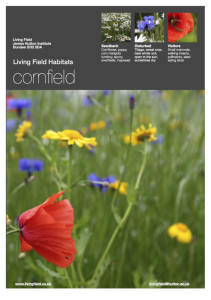
Plants of the cornfield are mostly annuals germinating at the same time as the crop and seeding before harvest. Names like corn cockle, corn marigold, cornflower, corn spurry reveal their long association with the wheats and barleys that were once collectively named ‘corn’.
These weeds adopted agriculture, sometimes thousands of years ago, and remained troublesome until the mid-1900s. Some such as the corn cockle are poisonous and had to be removed. Others, notably corn marigold or gool, have been serious weeds for centuries, at least until modern farming was able to control them.
A combination of chemical weedkillers, competitive crops at high density and demand by merchants for pure seed, has reduced these plants in the last half-century to the point where some became extinct and others very rare. And while the growing of crops needs to be efficient, the loss of cornfield plants is seen by some as a loss of heritage and perhaps more importantly a loss of cogs in the ecological machinery. Look at Van Gogh’s paintings of wheat fields to see the spatial variety and the mixing of a tall cereal with a range of other botanical shapes and forms.
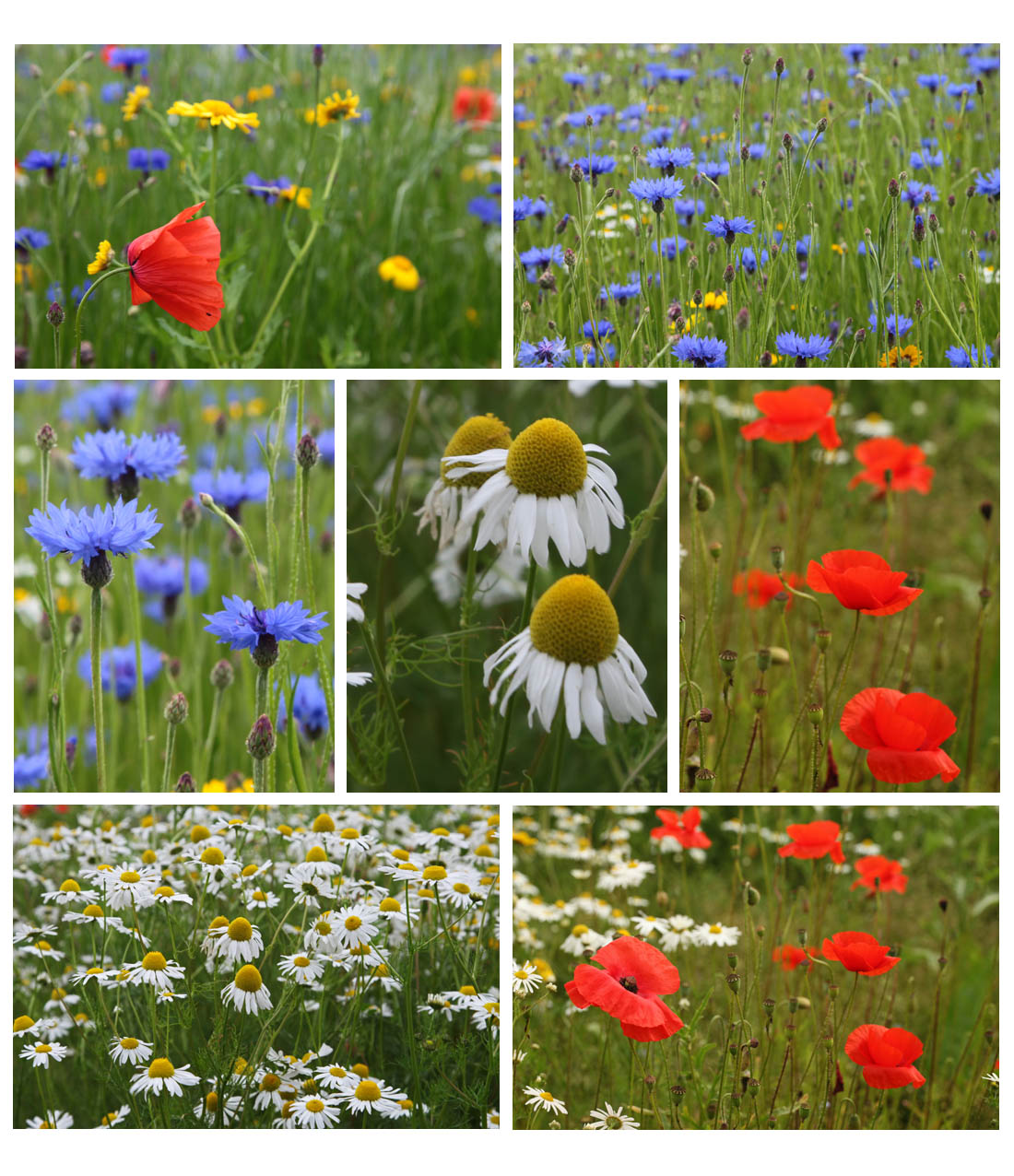
Not all are gone. Occasionally, fields still appear covered in the indistinct blue haze of cornflower, so seed must reside in the soil in some places. Corn spurry, once a sown forage, remains one of the commonest weeds of low-input cropping, while mayweeds are still everywhere.
Wildflower specialists also sell cornfield mixtures, even including the now rare and extinct-in-the-wild species, so it is still possible to see these plants, but more likely in urban meadows or on a new roadside verge or roundabout than in a field.
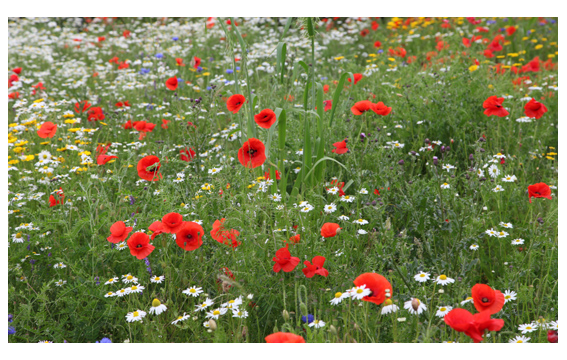
Weeds are still a problem for growing wheat and barley, but today’s serious weeds such as cleavers, wild oat and blackgrass are more aggressive than the old ones, not as attractive and less valuable to the farmland food web. In many cases, heavy weed control just trains new weeds.
Here are some of the species.
Corn marigold Chrysanthemum segetum – the one with the all-yellow flowers in the photographs – is now rare in cereal fields but was once a noxious weed, known as gool, and some of its weedy characteristics remain, because it is the one sown cornfield species that moves around and persists in other parts of the garden. For more on gool, see Weeds and the law under ‘sources’ below.
Cornflower Centaurea cyanus, the blue flower in the photographs, is now rare in agriculture, but easy to grow in the garden, though it soon gives way to more competitive biennials and perennials. In some years, it lasts in flower for insect visitors up to the first frosts of autumn.
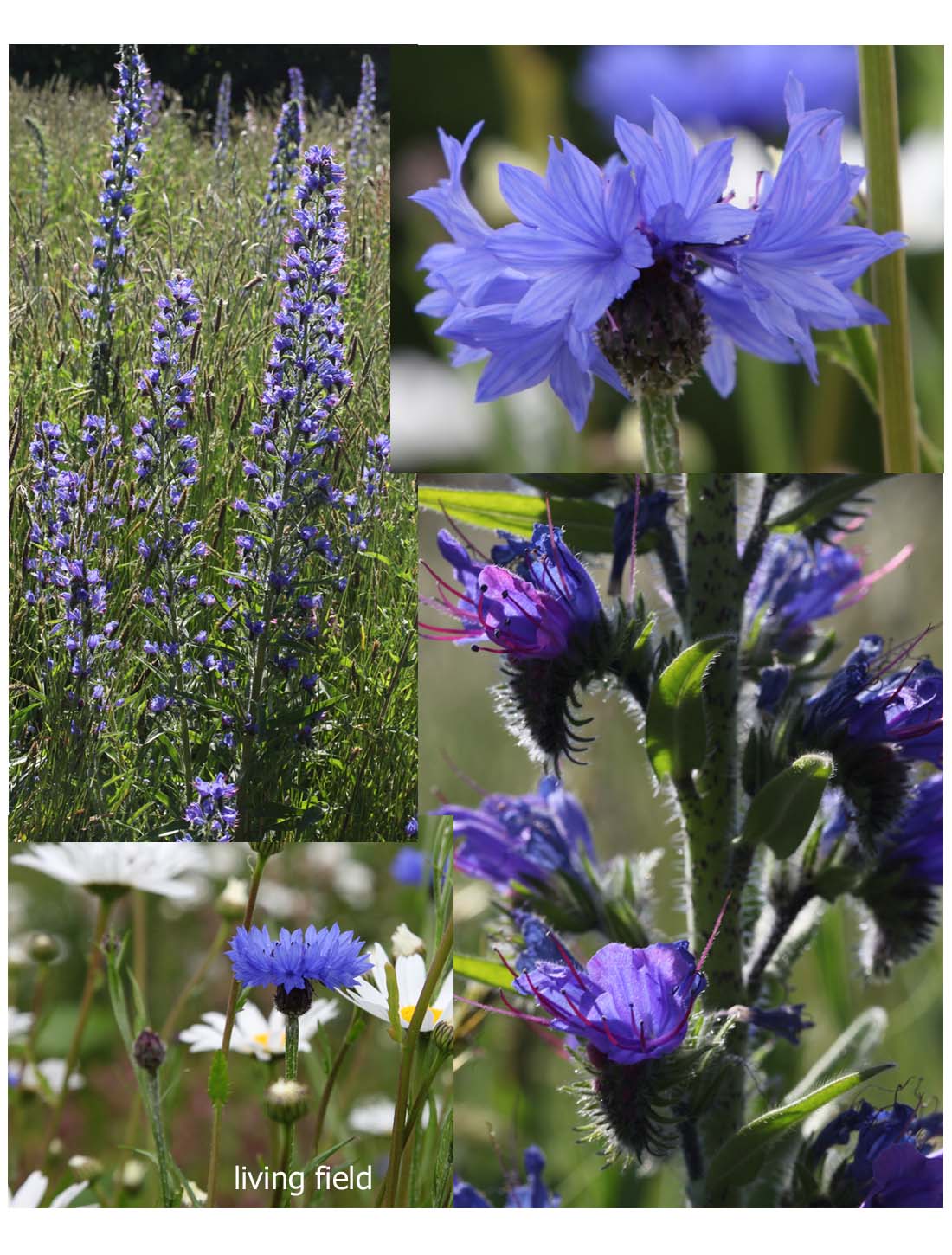
In 2011, the Living Field helped with sowing and planting around the mill pond at the Hutton Institute’s Balruddery Farm. The images above are of (upper left) viper’s bugloss spikes among grass, lower left) cornflower with oxeye daisy and (right) closer view of the flowers.
Corn spurry Spergula arvensis can easily be missed, but its finely cut leaf, small white flowers and greenish, round seed pods, often form a dense matt below cereals in low-input rotations. It was once a sown forage, and is now not a serious weed in most arable fields. It grows all over the place in the garden.
Mayweeds Of the three commoner species, scented mayweed Matricaria recutita and scentless mayweed Tripleurospermum inodorum occupy in-field habitats, whereas pineapple weed Matricaria discoidea (the one without the outer white ray florets and smelling of pineapple) prefers rough ground around field gates and waysides. They have finely cut foliage, like the chamomiles (which are uncommon in fields), but very different from the oxeye daisies. The scented and scentless mayweeds are difficult to tell apart as emerged seedlings and even as young plants before flowering; they sometimes have a similar smell. Mayweeds are still among the top ten most common plants of arable rotations.
Poppies bring that characteristic bright red to the cornfield.Those in the garden are mostly long-headed poppy Papaver dubium, though common poppy Papaver rhoeas also grows here. Occasionally in fields the opium poppy Papaver somniferum appears, but in the garden this species is confined to the collection of medicinals.
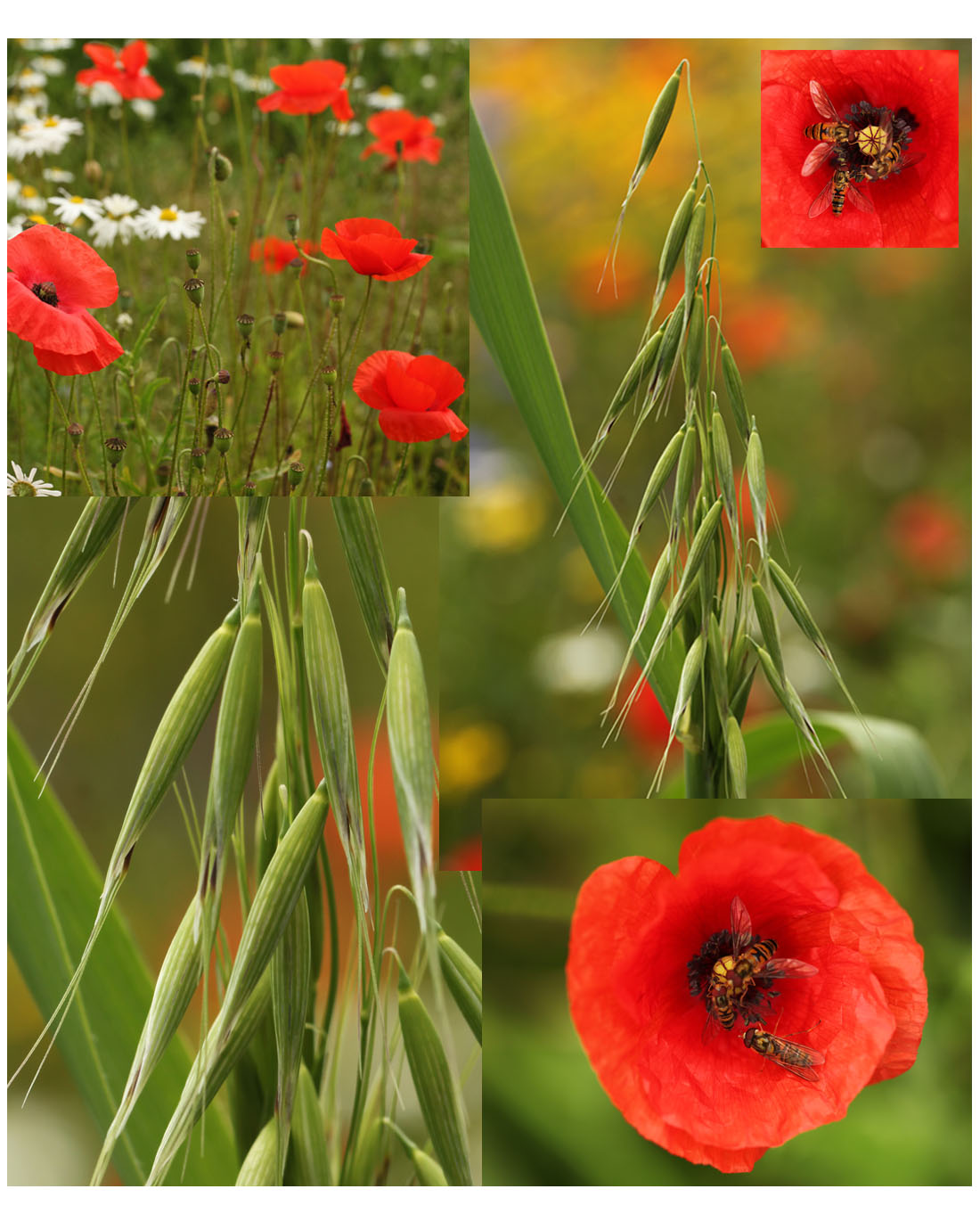
The images above contrast one of the most noxious and troublesome weeds, wild oat Avena fatua, and the iconic flower of the cornfield, poppy. Wild oat’s flowering panicle is similar in appearance to that of the cultivated black oat but much more lax than the compact modern oat (porridge and oatcakes). Yet if allowed, wild oat grows up thickly in wheat or barley, rising taller than the modern crop varieties, taking sunlight and nutrients, and at harvest, dropping seed to increase its buried seedbank.
So while the poppy and cornflower and many other plants of the field are on the decline, the wild oat, and other grass weeds including the bromes in the north, have come to mimic the life cycles and structures of the main cereal species, thereby ensuring they continue to thrive in modern high input cropping.
Meadow plants and arable weeds
Some of the meadow plants appear in cornfields, but the distinction is that the meadow consists mainly of perennials that come up year after year, while cornfield plots are mainly annual plants, emerging and seeding within one year. Cornfield plots also support biennials such as viper’s bugloss Echium vulgare, which germinate one year, then remain usually as a basal rosette of leaves over the winter before extending upwards and flowering the next year.
Several arable weeds emerge from the existing buried seedbank to grow among the sown cornfield annuals in the garden. Chief among the weeds are fat-hen Chenopodium album, once a salad vegetable (and still is in many parts do the world) and no longer a serious weed, field pansy Viola arvensis, speedwell Veronica persica, forget-me-not Mysotis arvensis, various fumitories Fumaria species and sow-thistles Sonchus oleraceus and Sonchus asper.
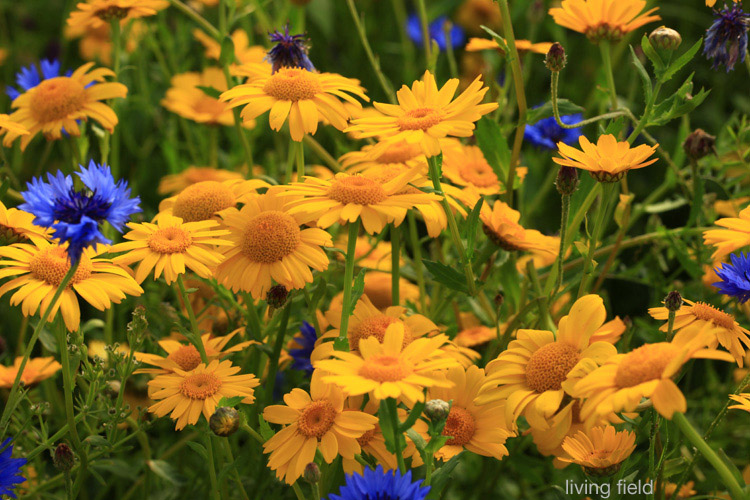
Management
In north-west Europe, ‘spring’ crops grow for about six months, sown in late March and April to be harvested in September or later the same year. ‘Winter’ crops grow for around 11 months, sown in September and October (some in late August) to be harvested in August or September the following year.
In the garden and nearby strips of land, cornfield annuals are generally sown from bought-in seed in spring, but without the corn. They germinate freely in prepared ground and form light stands of mainly poppy, cornflower, corn marigold and mayweeds in the first year with a few seedbank weeds. Their seed dropped at the end of the first year forms a ‘seedbank’ in the soil.
The same species will emerge from the seedbank next spring and then drop seed again in the second year. They may be joined by legumes, particularly tufted vetch Vicia cracca, and with biennials such as viper’s bugloss Echium vulgare and some weedy thistles. By late in the second year, the open annual canopies have become thick tangles in which perennials get the upper hand.
Unless the ground is cleared of all vegetation and the soil disturbed, most of the cornfield annuals will have gone by the third year, not able to germinate and emerge through the dense tangle of other plants. Every year or so a new patch is prepared and cornfield plants sown. (There were none in 2014).
If you want cornfield annuals to return year after year, they have to be managed. Many cornfield plots sown on roundabouts and other bits of land by roads tend to be left unmanaged and soon progress to dense perennial vegetation dominated by grasses or the thistles.
Sources, references and links
Books
There are several excellent books and booklets on weeds but mostly published at a time when weeds were a major problem for arable land and pasture, so date from the 1920s to the 1960s. Those by Chancellor and Hanf, are good for identification and both still available second-hand.
For readers with a deeper interest, Brenchley’s title was the first substantial book on weeds in Britain and gives an idea of the practical and economic problems due to weeds before the pesticide years. Some cornfield plants are included in Ranson’s accounts of the herbal uses of plants. See also the Medicinals page on this site.
Brenchley WE. 1920. Weeds of farm land. Longman, Green and Co. London. 239 pages.
Chancellor RJ. 1966. The identification of weed seedlings of farm and garden. Blackwell Oxford. 88 pages. (One of the best for identification of seedlings.)
Hanf M. 1983. The arable weeds of Europe with their seedlings and seeds 1983 BASF. [http://web.adas.co.uk/WeedManager/FurtherReading.aspx].
Hubbard CE. 1954. Grasses. Second edition 1968. Penguin Books. 463 pages. (There are later, revised editions with different authors.)
Ranson F. 1949. British herbs. (Pelican) Penguin Books. 203 pages.
Weeds and the law
Colin Reid of Dundee University has kindly allowed us to make the following article available via a pdf. Reid CT, Reid MA. 1990. Weeds and the law. Journal of the Royal Caledonian Horticultural Society, (1990) 47-49. PDF: weeds_and_the_law 300 kb.
Organisations and web links
ADAS. Encyclopaedia of arable weeds. http://web.adas.co.uk/WeedManager/frontpage.aspx
ASIS. Arable seed identification system. James Hutton Institute.
Plantlife. Arable plants in Scotland. A management guide. Web site: http://www.plantlife.org.uk/scotland/about_us
